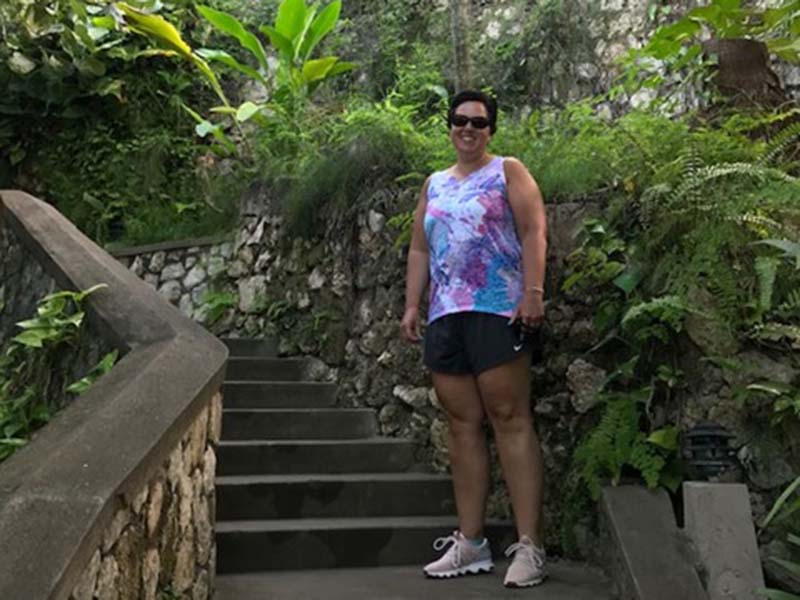When Tracy Herbeck had her routine yearly mammogram in January 2019, she wasn’t worried. She’d experienced no symptoms and felt nothing during her self-exam. But, her mammogram and a later ultrasound caught two suspicious spots.
“You sit at home and think this is never going to happen to me,” she said, “then it hits you that it’s real.”
Due for a mammogram? Schedule your screening at Sanford Health
Biopsies confirmed a stage one breast cancer diagnosis.
“I later told the radiologist that she saved my life. I hadn’t felt it,” Herbeck said.
A trip to Sioux Falls
Herbeck lives in Aberdeen, South Dakota, and works as a clinical documentation specialist at Sanford in Aberdeen. In February, she traveled with her husband to Sioux Falls to meet breast surgeon Jesse Dirksen, M.D.
“He started talking to me about my diagnosis. The first thing he told me is, ‘You don’t have to remember anything I’m going to say,’” Herbeck said.
That’s what nurse navigators are for.
When Herbeck and her husband sat down in Dr. Dirksen’s office, a nurse joined them. She wrote down everything the doctor said and walked the Herbecks through it again before the appointment ended.
“She made sure we understood our options and what would happen next,” said Herbeck.
Dr. Dirksen and the nurse navigator reviewed Herbeck’s treatment options, partnering with her to identify her best choice. She opted for a bilateral mastectomy.
Knowing Herbeck had traveled over three hours to get to the appointment, Dr. Dirksen asked his colleague Heather Karu, M.D., if she could meet with Herbeck that day. Dr. Karu, a plastic surgeon who specializes in reconstructive surgery, took the time to visit with Herbeck right away.
Just like her appointment with Dr. Dirksen, Dr. Karu gave Herbeck the information she needed to make a decision. Together, they determined an implant option that felt right.
Chemotherapy in Aberdeen
Later that February, Herbeck had the mastectomy and reconstructive surgery in one day, returning to Aberdeen to start chemotherapy in March.
“I chose to stay close to home to go through chemotherapy,” Herbeck said.
Her doctor practiced in a small town but was part of a vast network of specialists. The Aberdeen provider attended a tumor board in Sioux Falls to discuss Herbeck’s case with other oncology specialists across Sanford Health.
“I didn’t ever feel like I’m just in Aberdeen, South Dakota — at a small hospital. I always felt that I was treated by all of Sanford Health.”
Throughout her treatment in Aberdeen, she got to know every member of her care team, and they got to know her.
“When you come in for treatment, even the receptionist gets to know you. And those nurses, they just sit down and talk with you. They make sure to take that time and never acted like they were in a big hurry. I’m sure they had plenty of work to do, but I never felt that,” she said.
Ringing the bell
Herbeck went through chemotherapy for three months and then had immunotherapy for a year. Her last infusion was in February 2020 — one year after her surgery.
“On the day of my last infusion, I was going to ring the bell that signals the end of your treatment. When I came around the corner to ring it, to my surprise, my family and friends and other specialists were there to celebrate,” she said. “I didn’t realize my parents were coming. It was great.”
Herbeck is now cancer-free. She wonders if her treatment would have turned out differently if her cancer hadn’t been caught as early as it was.
“If I had not had a screening, my breast cancer journey could have had a much worse outcome. A yearly mammogram is so important and usually covered by insurance,” she said.
Learn more
- Mammography: Answers to common questions
- Breast cancer severity goes down with mammography screening
- One in Eight podcast: Determining your breast cancer risk factor
…
Posted In Aberdeen, Cancer, Cancer Screenings, Cancer Treatments, Imaging, Sioux Falls
